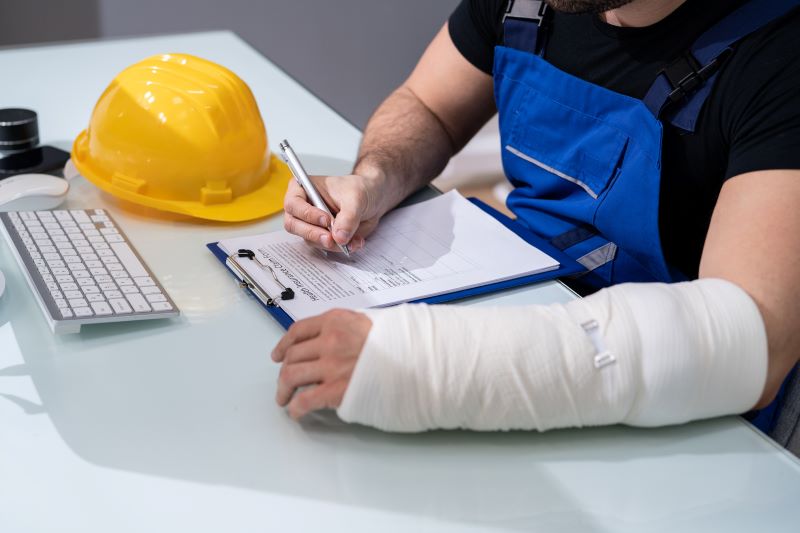Navigating the complex world of workers’ compensation can be daunting, especially for those in the physically demanding construction field. Construction workers are often exposed to hazardous conditions that can lead to serious injuries, making understanding the process of filing for workers’ compensation crucial.
This guide aims to simplify the process, ensuring that construction workers can confidently pursue the benefits they deserve in the event of a workplace injury.
Understanding Workers’ Compensation For Construction Workers
Workers’ compensation is an insurance designed to provide financial benefits and medical care for employees who get injured at work or become sick because of work-related activities. This coverage is particularly important for construction workers who are routinely exposed to high-risk conditions. It’s designed to cover medical expenses, lost wages, and rehabilitation costs, helping injured workers recover and return to work.
For those navigating the complexities of workers’ compensation claims, seeking legal assistance can be invaluable. A specialized workers comp law firm can provide the expertise and guidance necessary to navigate the intricacies of the law, ensuring that construction workers receive the full benefits they’re entitled to.

Steps To File For Workers’ Compensation
Navigating the workers’ compensation process can be daunting, especially after a workplace injury. Below are the essential steps to file for workers’ compensation, ensuring injured employees understand how to initiate their claim, document their injury, and seek the benefits they’re entitled to, all aimed at a smooth and supported recovery:
-
Report The Injury
The first and most critical step is to report the injury to the employer immediately. Many states have strict deadlines for reporting workplace injuries, typically ranging from 24 hours to 30 days. Failure to report the injury within this timeframe can jeopardize the injured party’s ability to receive compensation.
Given the complexity and potential legal hurdles involved in initiating a workers’ compensation claim, speaking to a construction accident attorney can be a strategic move. An attorney with experience in construction-related injuries can offer tailored advice, represent the injured party in hearings, and help navigate disputes, ensuring their rights are protected throughout the process.
-
Seek Medical Attention
Immediately after a workplace injury, the injured party should seek medical attention, not just for their health but also to officially document the incident and its implications on their work capacity. When consulting a healthcare professional, it’s essential to explicitly mention that the injury is work-related.
This specification ensures that the medical records accurately reflect the work-related nature of the injury, serving as a cornerstone for the workers’ compensation claim. These records are indispensable, as they provide irrefutable evidence of the injury and its direct link to the job, which is critical when seeking compensation.
-
File A Workers’ Compensation Claim
Once the injury is reported to the employer, they’re obligated to furnish the injured party with the appropriate claim forms for workers’ compensation. It’s critical to approach this step with diligence, ensuring every detail on the form is filled out meticulously and truthfully, reflecting the circumstances of the incident. These completed forms must then be submitted to the state’s workers’ compensation board within the required deadlines, which can vary significantly from one state to another.
Adhering to these deadlines is crucial, as any deviation could compromise one’s claim’s validity and, by extension, the injured party’s entitlement to benefits.
-
Obtain Documentation
The success of the workers’ compensation claim significantly depends on the thoroughness and organization of the documentation. Hence, it’s crucial to start by compiling every piece of evidence related to the injury and subsequent treatment. This documentation should include all medical records, detailed bills, receipts, and any written communication with the employer regarding the incident.
This documentation serves a dual purpose: it substantiates the claim of injury and its connection to the work environment, and it lays out the financial implications of the medical treatment received. By meticulously organizing this evidence, the injured party can bolster their claim, ensuring that no detail is overlooked in the pursuit of the compensation they are eligible for.
-
Attend Required Meetings And Hearings
When pursuing a workers’ compensation claim after a construction accident, the injured employee might need to participate in various meetings or hearings as part of the claims process. These formal gatherings serve as platforms for all parties involved to delve into the case’s specifics. It’s of utmost importance for the claimant to come prepared, armed with a comprehensive suite of documentation that corroborates their claim. This includes medical records, injury reports, and any relevant correspondence.
Presenting the case with clarity and precision is crucial; this demonstrates the legitimacy of the claim and ensures that the narrative is coherent and persuasive. Being well-prepared and articulate in these settings significantly enhances the likelihood of a favorable outcome in the compensation claim process.
Conclusion
Filing for workers’ compensation can seem overwhelming, particularly in the aftermath of a construction site injury. However, by keeping the information mentioned above in mind, the construction workers can navigate the system more effectively. This ensures that they receive the necessary medical care and financial support to aid in their recovery, allowing them to return to work safely and with confidence.

